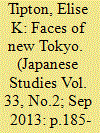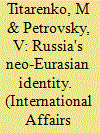| Srl | Item |
| 1 |
ID:
123491


|
|
|
|
|
| Publication |
2013.
|
| Summary/Abstract |
This study focuses on a comparison of the three most popular sakariba (entertainment districts) in Tokyo of the late 1920s and 1930s to highlight the new role of leisure in everyday life as Japan industrialized and urbanized. The comparison of Asakusa, Ginza and Shinjuku shows that even as Japan became a mass society, leisure practices and patterns became stratified and diversified. This stratification and diversification reflected class, age and cultural tastes. The three sakariba developed distinctive characters and attractions for consumers, raising challenges to mass culture critics' assumption that the rise of mass culture and commodity culture would lead to homogenization of taste and recreational products and a lack of consumer choice.
|
|
|
|
|
|
|
|
|
|
|
|
|
|
|
|
| 2 |
ID:
094822


|
|
|
|
|
| Publication |
2010.
|
| Summary/Abstract |
In Egypt, during the late 19th and early 20th centuries, older, fragmented, and more localized forms of identity were replaced with new, alternative concepts of community, which for the first time had the capacity to collectively encompass the majority of Egyptians. The activism of Mustafa Kamil (1874-1908) and the populist message of the Watani Party began the process of defining and popularizing urban Egyptian nationalism. After Kamil's premature death in 1908, there was more of an "urgent need," as described by Zachary Lockman, for "tapping into and mobilizing new domestic constituencies in order to build a more broadly based independence movement." This article argues that the eventual mobilization of the Egyptian urban masses, and their "incorporation into the Egyptian nation," was due in large part to the materialization of a variety of mass media catering to a growing national audience. To be more specific, I will examine early Egyptian nationalism through the lens of previously neglected audiovisual colloquial Egyptian sources. This, I argue, is crucial to any attempt at capturing the voice of "ordinary" Egyptians. Finally, the article documents the role of early colloquial Egyptian mass culture as a vehicle and forum through which, among other things, "hidden transcripts" of resistance and critiques of colonial and elite authority took place.
|
|
|
|
|
|
|
|
|
|
|
|
|
|
|
|
| 3 |
ID:
146301


|
|
|
|
|
| Summary/Abstract |
RUSSIA'S STRATEGIC TURN to the East has revived the academic and social-political discussion about our country's Eurasian self-determination and an adequate understanding of its Eurasian identity. It seems, however, that we have not yet grasped the true philosophical, geoeco-nomic and geopolitical significance of Russian Eurasianism; we should arrive at its comprehensive understanding and formulate its definition.
|
|
|
|
|
|
|
|
|
|
|
|
|
|
|
|